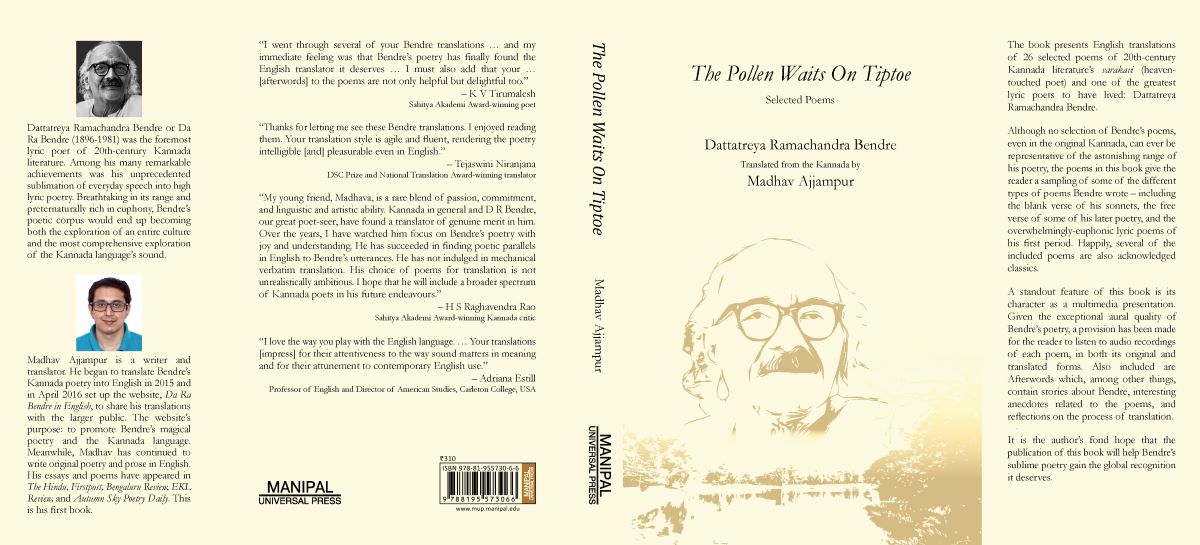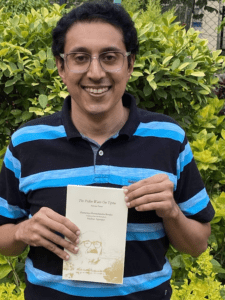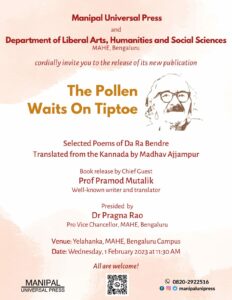Madhav Ajjampur is an obsessive-compulsive translator, the only variety of translators that should be allowed to exist. But his success owes to something more than the obsessions.

The back and front covers and the flaps of 'The Pollen Waits on Tiptoe', Madhav Ajjampur's English translations of selected poems by DR Bendre, Kannada’s foremost lyric poet (Supplied)
In translating the celebrated Kannada poet, the Varakavi, Dattatreya Ramachandra Bendre, into English, Madhav Ajjampur has achieved something of a feat in his The Pollen Waits on Tiptoe.
DR Bendre was a poet known for his endless linguistic innovation. These innovations were not formal experiments like that of the modernist poets. They were innovations that attempted to seek flashes of adhyatmic insights through euphony.
Bendre’s poems were lyrical and influenced by folk forms, especially those prevalent in the overlapping cultural zone of Kannada-Marathi.
He was a Navodaya poet, and so his themes sometimes sound dated to the contemporary sensibility.
For instance, his concern about the rejuvenation of the Kannada people, although not in a necessarily nationalist manner, and his celebration of the modern deity Mother Kannada, seen as an avatar of a more traditional deity such as Chamundeshwari, his lyrics and songs celebrating the seasons, as well as his engagement with the many bhakti traditions.
If this was not complex enough, Bendre had a very highly sophisticated, although idiosyncratic, engagement with the main darshana traditions of India, especially Samkhya, Yoga, and the mainstream Vedantic traditions.
He considered Aurobindo a guru figure. He dabbled in numbers, numerology, and even modern science. His poetry seamlessly brings together all of his preoccupations into a single whole.
For a rough comparison, imagine a poet who is a mix of a Burns, a Blake, and a Nirguni Kabir! You can’t. And that is the difficulty of capturing Bendre.
No doubt, translating any poetry is difficult. But the problem with translating DR Bendre’s poems is that he is already working on the edge of the possibilities of language, not just the possibilities of a specific language, in his case Kannada, but at the edge of the possibilities of human language itself.
He hopes to make his words begin with a reference to objects, and through a complex onomatopoeia, discoverable only by him, he hopes to make it refer to actions, and then to primal sounds, and then to a vision of something beyond the pale of language: to the experience of the Para (the other) from the tools of the Iha (the this).
Consider, for example, this line:
tum tum tumtum tumtum tumtum tumbi banditta
The reader expects something about a tumbi, a bumblebee. The rest of the poem develops this metaphor to talk about the coming of a tumbi in a very playful and sensuous language.
But then, almost unrecognisably, the metaphor’s connotations change, and the references become rather mystical and inward-looking. It now appears like we are no longer talking about things that can be associated with a flying insect, but with a state of experience.
And by the end of the poem, almost as if in a trance, almost as if he committed a slip of the tongue, the poet says:
eega tuluki hogitta (it had now overflowed).
Now we see that the word tumbi was not just a noun but also a verb which means “filled”, “full”, etc.
We were all the time talking about an experience that overwhelms the self, and takes one to a realm beyond the dualities inherent in language and intellection. But we talked about it in the language of the coming of a winged, airy creature, like a thought.
Little did we suspect that it was more than a bumblebee, and more than a thought, it was an experience, a realisation. (Readers should refer to the afterword that Ajjampur has written to each of his translations, and particularly to this poem. They are elaborate, diligent, and nimble reflections on the tonal and the lyrical aspects of translating Bendre.)
The singularly great success of this anthology is the translation of the DR Bendre poem Jogi.
Entire books have been written about this one poem and it has been called the Kannada poem of the century. It speaks about an encounter with the Jogi, the Yogi, who shall transform one’s own life profoundly, irreversibly.
Connoisseurs of Kannada poetry had all but relegated this as a poem untranslatable-par-excellence. Ajjampur’s translation of this Bendre poem has shattered that consensus.
Consider the lilting rhythm of these lines, set in strict tetrameters and end-rhymes, but made to flow smoothly with very ordinary and yet precise words:
Upon that tree, within this lush has come a single koel,
it calls to me to come to it like I am its mate-of-soul;
Or,
The hills around have shattered now in echoing its call,
the sunshine’s danced and come to sweat — it’s set for the rain to fall.
Ajjampur’s success is not only in forging a lyrical language, which conveys Bendre’s many euphonies, assonances, and a diction which borrows from many sources of English verse-making: the Romantics and the Victorians in particular.
He is an obsessive-compulsive translator, the only variety of translators that should be allowed to exist. His notes to his translations go to great lengths explaining word choices, meters, rhymes, emphasis, and a dozen other intricacies of translating poetry.

Madhav Ajjampur with ‘The Pollen Waits on Tiptoe’, his English translation of selected poems by DR Bendre (Supplied)
But his success owes to something more than these obsessions. It is in large measure due to a sensibility that follows Bendre like a calf finds a cow.
Ajjampur’s own epigraphic poem in English titled To Bendre Ajja: In Gratitude speaks eloquently of this sentiment, This sensibility of a vatsa, a calf and a child, has been the hardest to achieve for most translators of the poet.
To most modern ears, the very possibility of such a sensibility might sound alien, if not downright freakish. A modern translator, uncomfortable with the perplexing unities that Bendre creates between different aspects of our everyday and transcendental experiences, ends up aestheticising Bendre, or makes him sound like a formal experimenter, a la Jorg Luis Borges or a John Cage.
They try to make the images in his poetry sparkle like standalone vignettes.
It doesn’t work because Bendre is not a poet of images or experiments, descriptions or narrations, feelings or emotions. He is a poet who integrates all this to achieve a mantric experience of poetry. He keeps company with the celestials.
In Ajjampur’s translation, DR Bendre says:
the Naarayana of the lotus-heart has himself turned into the mortal Datta;
as Ambikaatanaya he mirrors here in Kannada the universe’s inner voice.
You could see in this the excesses of a psychologically strange subjectivity, given to mystic escapades.
You could also situate such a subjectivity in the emerging Hindu-nationalist renaissance of the nineteenth to mid-twentieth century, with its aspirations to forge a Vedantic-civilisational milieu for an emergent nation.
But if you want to succeed at translating Bendre, you need to see this as an experience that a mind has experienced. You need to render that experience plausible.
Ajjampur is probably the closest we have yet gotten to such a rendering of DR Bendre.
(‘The Pollen Waits on Tiptoe: Selected Poems’, Dattatreya Ramachandra Bendre, Translated from the Kannada by Madhav Ajjampur, Manipal Universal Press, Manipal, 2022, Pages 196. Price ₹310.
The book launch will take place in Bengaluru on 1 February 2023, Wednesday. The details are below)
 (AP Ashwin Kumar is an associate professor at Ahmedabad University, working in the area of philosophy of culture. His book ‘Nationalism, Language, and Identity in India: Measures of Community’ is published by Routledge. He also writes in Kannada)
(AP Ashwin Kumar is an associate professor at Ahmedabad University, working in the area of philosophy of culture. His book ‘Nationalism, Language, and Identity in India: Measures of Community’ is published by Routledge. He also writes in Kannada)

Apr 19, 2024

Apr 19, 2024

Apr 19, 2024

Apr 19, 2024

Apr 19, 2024